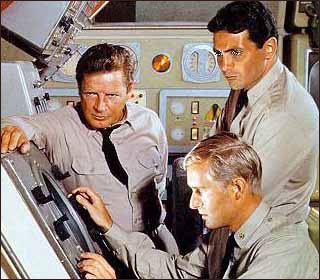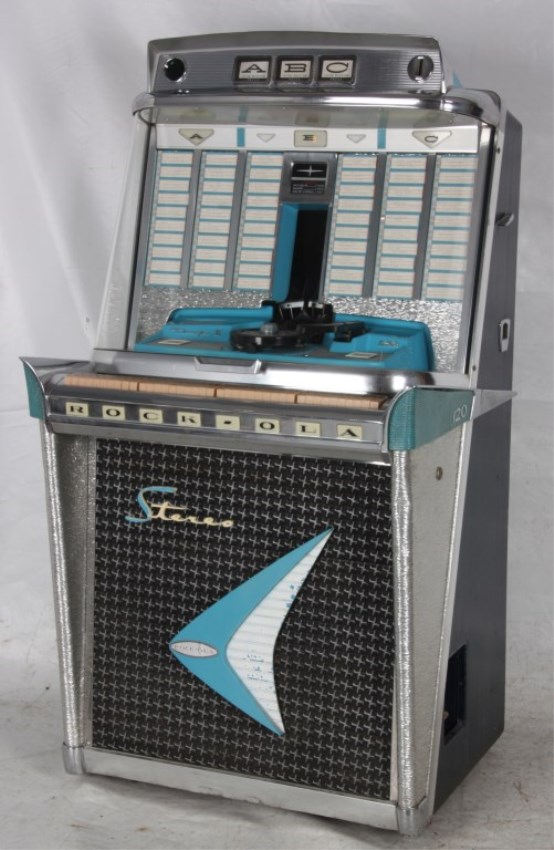
The 60s Official Site
"Where Music is Our Middle Name"
Quick Links
Soundtrack of the 60s with Neal Stevens
Todays Trivia Question. Your Daily Oldies Fix Top Ten Countdown Solid Gold Memories Jukebox Music
Vibration of a Nation Remember When Television of the 50s and 60s Do You Remember These 60s Slang
Things You Just Don't Hear Anymore 60s TV Commercials Chickenman Episodes Woodstock This Weeks Number One Hits
The Early Years of Rock and Roll Vietnam War Myths
All the content menu is listed on the left menu border bar
Voyage to the Bottom of the Sea
Voyage to the Bottom of the Sea is a 1960s American science fiction television series based on the 1961 film of the same name. Both were created by Irwin Allen, which enabled the movie's sets, costumes, props, special effects models, and sometimes footage, to be used in the production of the television series. Voyage to the Bottom of the Sea was the first of Irwin Allen's four science fiction television series. The show's main theme was underwater adventure. Voyage to the Bottom of the Sea was broadcast on ABC from September 14, 1964 to March 31, 1968, and was the decade's longest-running American science fiction television series with continuing characters. The 110 episodes produced included 32 shot in black and white (1964–65), and 78 filmed in color (1965–68). The first two seasons took place in the then future of the 1970s. The final two seasons took place in the 1980s. The show starred Richard Basehart and David Hedison. In the pilot episode "Eleven Days to Zero", which was filmed in color but shown in black and white, the audience is introduced to the futuristic nuclear submarine Seaview and the lead members of her crew. Most notable is the designer and builder of the submarine, Admiral Harriman Nelson (Richard Basehart). We also are introduced to the Nelson Institute of Marine Research (NIMR) in Santa Barbara, California which serves as a support structure for the Seaview. The Seaview is often moored, when at the base, some 500 feet below ground level in a secret underground submarine pen, Dock C-4, carved out of solid rock-although much of the drydock appears to be constructed of large stones. The submarine's official status is for undersea marine research, but its secret mission is defend the planet from all world and extraterrestrial threats. We learn, not for the last time, that the series is set in the then-future of the 1970s. The pilot episode tells the story of how Commander Lee Crane (David Hedison) became the Seaview’s Captain after the murder of her original commanding officer, Commander John Phillips. At the end of the episode, we learn that the series will be about the adventures of the Seaview and her crew roaming the seven seas and visiting many exotic locations. The Seaview and her crew's primary task in the series will be to probe the mysteries of nature and fight forces that threaten the survival of the United States and the entire world.
In the first season, the gritty, atmospheric, and intense series featured story lines devoted to Cold War themes, as well as excursions into near-future speculative fiction. Many episodes involved espionage and sci-fi elements. While aliens and sea monsters, not to mention dinosaurs, did become the subject of episodes, the primary villains were hostile foreign governments. While fantastic, there was a semblance of reality in the scripts. The second season began with a trip inside a whale, and saw
several brushes with world disaster. The season ended with a ghost story, one of the show's few
sequels. The most important change in the series occurred during this season when a slightly redesigned Seaview was introduced, along with the Flying Sub. The Flying Sub was a yellow, two-man mini-submarine with passenger capacity, that could leave the ocean and function as an airplane. The Flying Sub was referred to by the initials FS-1. The futuristic craft greatly increased Seaview crews' travel options. The Flying Sub was launched from a bay in the lower part of Seaview that was apparently built between Seasons One and Two. The Seaview’s private observation deck from the first season was never seen again. The Seaview’s eight observation windows became four. The Seaview’s enlisted men were also given more colorful uniforms (red or light blue jumpsuits), evidently to take advantage of the changeover from black and white to color. The officers and petty officers, however, retained their khaki works from the first season. The traditional sailor uniforms worn in the first season were only seen in stock footage from the first season and on characters who were newly filmed to match up with that footage. All these changes occurred between seasons. The Flying Sub was showcased in the show's closing credits for the entire season. The "Flying Sub' also made an appearance in the 1971 Irwin Allen
film, City Beneath the
Sea (1971 film). he third season of Voyage to the Bottom of the Sea ran simultaneously with two other Allen-produced television series: the second season of Lost in Space and the premiere (and only) season of The Time Tunnel. The third season began with Dick Tufeld of Lost in Space playing
an evil disembodied brain from outer space. The season continued with a werewolf story that is one of the few
episodes to inspire a sequel. In one episode, the Seaview’s officers and crew encountered Nazis who believed
World War II was still ongoing. The third season only had two espionage stories and one ocean peril story that
were reminiscent of the first season. One of those three stories was about a hostile foreign government trying
to steal a strange new mineral with the aid of a brainwashed Admiral Nelson. This espionage story was the end of
the third season. The fourth and final season of Voyage began with Victor Jory playing a five century old alchemist. After a few episodes there were revamped opening credits. Near the end of the fourth season, there were three unrelated stories of extraterrestrial invasion in three weeks. There were two time travel stories in two weeks. The second of the two had the Seaview going back in time to the American Revolution. The episode ended with the Seaview returning to the present and sailing into television history. Ratings for the fourth season took a significant drop as the season progressed, but were not drastic enough for ABC to immediately cancel a fifth season for the series. During renewal discussions between Allen, 20th Century Fox and ABC, Allen instead proposed replacing Voyage with Land of the Giants. Based on a proposal consisting of only a reported two dozen pre-production concept paintings, ABC accepted Allen's proposed new series, and Voyage to the Bottom of the Sea was cancelled. |
|





